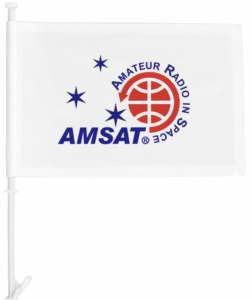In this edition:
- IO-117 GreenCube to cease operating on February 5
- AMSAT Responds to Scheduled Decommisioning of IO-117
- Apogee View
- New, Portable Antenna Satellite Antenna Design is Perfect for ECOM
- AMSAT Thanks 2023 President’s Club Members
- Changes to AMSAT-NA TLE Distribution for January 26, 2024
- ARISS News
- Upcoming Satellite Operations
- Hamfests, Conventions, Maker Faires, and Other Events
- Satellite Shorts From All Over
The AMSAT News Service bulletins are a free, weekly news and information service of AMSAT, the Radio Amateur Satellite Corporation. ANS publishes news related to Amateur Radio in Space including reports on the activities of a worldwide group of Amateur Radio operators who share an active interest in designing, building, launching and communicating through analog and digital Amateur Radio satellites.
The news feed on http://www.amsat.org publishes news of Amateur Radio in Space as soon as our volunteers can post it.
Please send any amateur satellite news or reports to: ans-editor [at] amsat [dot] org.
You can sign up for free e-mail delivery of the AMSAT News Service Bulletins via the ANS List; to join this list see: https://mailman.amsat.org/postorius/lists/ans.amsat.org/
ANS-028 AMSAT News Service Weekly Bulletins
To: All RADIO AMATEURS
From: Radio Amateur Satellite Corporation
712 H Street NE, Suite 1653
Washington, DC 20002
DATE 2024 JAN 28
IO-117 GreenCube to cease operating on February 5
At 1622 GMT on Thursday, January 25, 2024 @S5Lab posted on X that the GreenCube IO-117 Digipeater would be permanently deactivated on February 5.
Designed and developed by students of Sapienza University of Rome, GreenCube IO-117 was the first satellite to carry an amateur radio payload into Medium Earth Orbit (MEO) – 6,000 km.
The S5Lab post on X said:
Dear Friends,
After one year and a half of operations, it is time to conclude the GreenCube operations with the planned de-commissioning activities. After the conclusion of the nominal experiment and with the digipeater payload active for more than one year, we will perform the passivation operations for the satellite.
The planned passivation operations will be executed on Monday, 5 February 2024, at 00:00 UTC. From that day, GreenCube will be completely passivated and the digipeater will be switched off for good.
We want to thank everyone that endorsed, supported or participated in the mission and the radio amateur community that enthusiastically became a true part of our project. We hope that GreenCube will somehow be part of your memories of radio amateurs, space engineering enthusiasts, and we hope to involve you soon in many more adventures.
Thanks once again for the unbelievable memories shared together… See you soon!
The GreenCube Team at S5Lab
[ANS thanks AMSAT-UK for the above information.]
AMSAT Responds to Scheduled Decommisioning of IO-117
AMSAT leadership, as were all amateurs, saddened to learn that S5Lab plans to decommission IO-117 (GreenCube) and execute a passivation operation on February 5, 2024. AMSAT stands ready to leverage its decades of experience and work with S5Lab, AMSAT Italia, other AMSAT organizations, and the amateur satellite community at large to overcome any obstacles, regulatory or otherwise, to keeping IO-117 in service for as long as possible. This afternoon, AMSAT President Robert Bankston, KE4AL, sent the following letter to S5Lab expressing its desire to provide any support it can to keep the satellite in operation.
January 25, 2024
Sapienza Space Systems and Space Surveillance Laboratory (S5Lab)
Sapienza University of Rome
Via Email
To The GreenCube Team:
Over the past 13+ months, amateur satellite operators around the world have enjoyed the use of the digipeater on GreenCube (IO-117). As amateur radio’s first satellite in a medium earth orbit (MEO), it has opened worldwide long-distance contacts via amateur radio satellite that had not been possible since the loss of AMSAT-OSCAR 40 in 2004. As this letter is being written, a DXpedition to Clipperton Island in the Pacific Ocean has made contact with several hundred amateur operators around the world – the first activation of this rare location on amateur satellite in over 30 years. AMSAT and the amateur satellite community greatly appreciate your team making this wonderful resource available.
Not only has this satellite been a great resource to the amateur community, but the amateur community has also assisted GreenCube’s mission by uploading millions of frames of data received – including much data from when the satellite is not within the primary ground station’s footprint.
Launches above low earth orbit are rarely available for amateur satellite missions. Since the first amateur radio satellite launched in 1962, fewer than ten have gone to orbits beyond LEO and only QO-100 (available to only part of the world) and IO-117 remain in service.
Due to the unique orbit and capabilities, we request that S5Lab postpone the scheduled passivation operation and keep the satellite’s digipeater in service. Amateur satellites have a long tradition of extended lifetimes. Amateur radio operators still utilize AMSAT-OSCAR 7 – launched nearly fifty years ago in 1974 – for communications on a daily basis. Many other amateur radio satellites have been actively used for ten to twenty years. AMSAT stands ready to leverage our 55 years of experience in managing amateur radio satellites and work with S5Lab, AMSAT Italia, other AMSAT organizations, and the amateur satellite community at large to overcome any obstacles, regulatory or otherwise, to keeping GreenCube in service for as long as possible.
Sincerely,
Robert Bankston, KE4AL
President
Radio Amateur Satellite Corporation (AMSAT)
[ANS thanks AMSAT for the above information.]
+=+=+=+=+=+=+=+=+=+=+=+=+=+=+=+=+=+=+=+=+=+=+=+=+=+=+=+=+=+=+=+=+=+=+
The 2024 AMSAT President’s Club coins are here now!
Help Support GOLF and Fox Plus
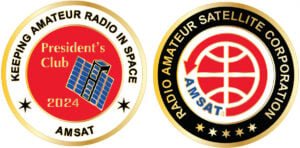
Join the AMSAT President’s Club today and help
Keep Amateur Radio in Space!
https://www.amsat.org/join-the-amsat-presidents-club
+=+=+=+=+=+=+=+=+=+=+=+=+=+=+=+=+=+=+=+=+=+=+=+=+=+=+=+=+=+=+=+=+=+=+
Apogee View
As 2023 comes to a close, it is a great time to reflect on where we are, what we have accomplished, and what is waiting for us over the next horizon. 2023 has passed by so quickly. Our presence at Hamcation led right into Hamvention, followed by our annual Symposium. We shared the AMSAT story with attendees at the CubeSat Developers Workshop and developed strategic contacts with others in the space industry. Our engineers on the GOLF team found a solution for an attitude determination and control system – a major sticking point in developing GOLF-TEE. The Fox Plus team made significant progress, with the possibility of being able to launch their first satellite at the end of the coming year. Our volunteers in the ASCENT program developed a new packet radio that will fly on an upcoming Fox Plus mission and started work on a software-defined radio (SDR) that will add greater flexibility to how we communicate in future flights. Additionally, if that was not enough, our Education and CubeSat Simulator team is nearing completion of the new v1.3 AMSAT CubeSat Simulator, which incorporates a Raspberry Pi Pico microprocessor.
AMSAT should…
Not a day goes by when an AMSAT member does not recommend a great idea to advance amateur radio in space, expand our communications footprint, educate new satellite operators, and make our organization more efficient. While I would love to implement each and every one of them, we do not have the resources to make it happen.
While we have never been in a better position financially, we need to have the necessary people to bring all these great ideas and dreams into reality. AMSAT is an all-volunteer organization. As such, we rely on our members to not only invest their hard-earned dollars but also roll up their sleeves to design, build, and launch amateur radio payloads into space.
Being short-staffed is not the end of the world, nor does it mean we must give up on our dreams. We just need to find creative ways to make it happen.
One solution is to partner with other AMSAT organizations worldwide on future satellite projects. We have already proven that together, we can accomplish so much more.
Additionally, we can outsource some of the basic satellite systems and components we have already mastered and focus our limited human resources on developing new technologies and communication methods. When AMSAT was formed in 1969, we were the only game in town. Now, you can’t google satellites without stumbling across a trove of commercial vendors who offer complete, flight-proven satellite packages with just a click of a button.
This same outsourcing principle can be applied not only to building satellites but to our administrative and back-office tasks, as well. We desperately need someone to assist in providing the quality of service that our members deserve, and our website seriously needs a complete makeover and rewrite.
In closing, I want to thank each of our volunteers and members personally. None of this would have been possible without your hard work, dedication, and support. We have an opportunity to achieve so much more with you. As we move forward into the coming year and beyond, I hope your generosity will continue.
Until the next time, 73!
[ANS thanks Robert Bankston, KE4AL, AMSAT President for the above information.]
New, Portable Antenna Satellite Antenna Design is Perfect for ECOM
Researchers at Stanford University and the American University of Beirut (AUB) have developed a portable antenna that could be quickly deployed in disaster-prone areas or used to set up communications in underdeveloped regions. The antenna, described recently in Nature Communications, packs down to a small size and can easily shift between two configurations to communicate either with satellites or devices on the ground.
“The state-of-the-art solutions typically employed in [disaster] areas are heavy, metallic dishes. They’re not easy to move around, they require a lot of power to operate, and they’re not particularly cost-effective,” said Maria Sakovsky, an assistant professor of aeronautics and astronautics at Stanford.
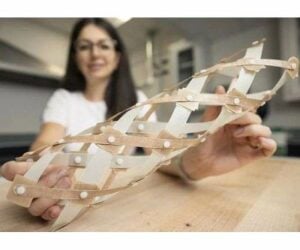
The antenna designed by Sakovsky and her colleagues at AUB is made of fiber composites (a material often used in satellites) and resembles a child’s finger-trap toy, with multiple strips of material crossing in spirals. Just like any helix-based antenna, conductive material running through the antenna sends out signals, but thanks to its unique structure, the researchers can adjust the pattern and power of those signals in the new antenna by pulling it into longer shapes or shorter shapes.
“Because we wanted the antenna to be able to collapse into a packable shape, we started with this structure that led us to a very untraditional antenna design,” Sakovsky said. At its most compact, the antenna is a hollow ring that stands just over 1 inch tall and about 5 inches across – not much larger than a bracelet – and weighs 1.4 ounces. In this shape, it’s able to reach satellites with a high-power signal sent in a particular direction. When stretched out to about a foot tall, the antenna sends a lower power signal in all directions.
“The frequency you want to operate at will dictate how large the antenna needs to be, but we’ve been able to show that no matter what frequency you operate at, you can scale this design principle to achieve the same performance,” Sakovsky said. To be deployed in the field, the antenna would need to be paired with a transceiver to send and receive signals, a ground plane to reflect radio waves, and other electronics, but the whole package would still only weigh about 2 pounds.
Read the complete story at http://tinyurl.com/ANS-028-Antenna.
[ANS thanks Stanford News and Space Daily for the above information.]
+=+=+=+=+=+=+=+=+=+=+=+=+=+=+=+=+=+=+=+=+=+=+=+=+=+=+=+=+=+=+=+=+=+
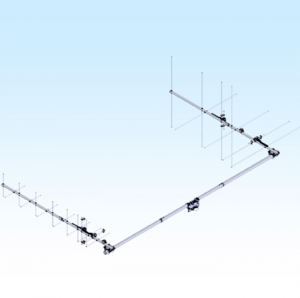
Need new satellite antennas? Purchase M2 LEO-Packs from the
AMSAT Store. When you purchase through
AMSAT, a portion of the proceeds goes towards
Keeping Amateur Radio in Space.
https://amsat.org/product-category/hardware/
+=+=+=+=+=+=+=+=+=+=+=+=+=+=+=+=+=+=+=+=+=+=+=+=+=+=+=+=+=+=+=+=+=+
AMSAT Thanks 2023 President’s Club Members
AMSAT gratefully recognizes the generous members of the 2023 AMSAT President’s Club. These AMSAT members together contributed $52,542 in 2023 to support AMSAT’s continuing innovations in engineering and educational programs. Since its inception three years ago, President’s Club members have raised well over $150,000 as AMSAT prepares for Amateur Radio’s continued presence in space with the Fox Plus and GOLF programs.
AMSAT invites you to become a member of this select group by visiting the announcement at https://www.amsat.org/join-the-amsat-presidents-club/.
TITANIUM LEVEL ($4,800+)
Anonymous
Barry Baines, WD4ASW
Alan Biddle, WA4SCA
William Brown, K9LF
PLATINUM LEVEL ($2,400+)
Steve Belter, N9IP
Doug Tabor, N6UA
GOLD LEVEL ($1,200+)
John Botti, KC8OKB
Burns Fisher, WB1FJ
Mark Hammond, N8MH
Frank Karnauskas, N1UW
John Kludt, K7SYS
Glenn Miller, AA5PK
Mary Monteiro
Michael Stipick, KC4RI
SILVER LEVEL ($600+)
Warren Fugate, W3WE
Mark Johns, K0JM
Joseph Lynch, N6CL
Thomas Oates, KQ4FJW
Bruce Paige, KK5DO
Peter Pendergast, W2PP
Scott Shaheen, WB8OOJ
Jason Schwarz, N4JJS
BRONZE LEVEL ($300+)
Allen Kenny, KK4AK
Edward Krome, K9EK
Donald Lum, WA6ICW
Bruce Perens, K6BP
Donald Pettigrew, K9ECT
Barbara Simpson, KA5CFB
Dave Taylor, W8AAS
James Tittsler, 7J1AJH
David Vine, WA1EAW
CORE LEVEL ($120+)
Arlan Arrison, KB2AYU
David Batzie, N2VDY
Randy Berger, WA0D
Alan Boggs, K7IIV
George Carr, WA5KBH
Jim Clary, ND9M
Richard Dittmer, KB7SAT
Todd Dugdale, KD0TLS
Drew Glasbrenner, KO4MA
Stephan Greene, KS1G
David Hartrum, WA3YDZ
Brian Lopeman, KI7WXP
Art Payne, VE3GNF
Thomas Schaefer, NY4I
Larry Schroeder, KD4HSL
Martin Shinko, KB3AEV
Paul Stoetzer, N8HM
Stefan Wagener, VE4NSA
Jeremy Wyatt, KA2PFD
David York, N8SGZ
[ANS thanks Frank Karnauskas, N1UW, AMSAT VP – Development for the above information.]
+=+=+=+=+=+=+=+=+=+=+=+=+=+=+=+=+=+=+=+=+=+=+=+=+=+=+=+=+=+=+=+=+=+
Want to fly the colors on your own grid expedition?
Get your AMSAT car flag and other neat stuff
from our Zazzle store!
25% of the purchase price of each product goes
towards Keeping Amateur Radio in Space
https://www.zazzle.com/amsat_gear
+=+=+=+=+=+=+=+=+=+=+=+=+=+=+=+=+=+=+=+=+=+=+=+=+=+=+=+=+=+=+=+=+=+
Changes to AMSAT-NA TLE Distribution for January 26, 2024
Two Line Elements or TLEs, often referred to as Keplerian elements or keps in the amateur community, are the inputs to the SGP4 standard mathematical model of spacecraft orbits used by most amateur tracking programs. Weekly updates are completely adequate for most amateur satellites. Elements in the TLE bulletin files are updated daily. TLE bulletin files are updated to add or remove satellites as necessary Thursday evenings around 2300 UTC, or more frequently if new high interest satellites are launched. More information may be found at https://www.amsat.org/keplerian-elements-resources/.
The following satellites have been removed from this week’s AMSAT-NA TLE distribution:
DCBB NORAD Cat ID 40912 Decayed from orbit on or about 21 January 2024
[ANS thanks Joe Fitzgerald, KM1P, AMSAT Orbital Elements Manager for the above information.]
ARISS NEWS
Amateurs and others around the world may listen in on contacts between amateurs operating in schools and allowing students to interact with astronauts and cosmonauts aboard the International Space Station. The downlink frequency on which to listen is 145.800 MHz worldwide.
Upcoming Contacts
Omer Cemile Guler Imam Hatip Secondary School, Konya, Selcuklu, Turkey, telebridge via VK4KHZ.
The ISS callsign is presently scheduled to be TC100ISS.
The scheduled crewmember is Alper Gezeravci, KJ5DIY.
The ARISS mentor is ON6TI.
Contact is go for Tuesday, January 30, 2024 at 13:36:20 UTC.
Bandirma Sehit Guvenc Anatolian High School, Balikesir, Bandirma, Turkey, telebridge via IK1SLD.
The ISS callsign is presently scheduled to be TC100ISS.
The scheduled crewmember is Alper Gezeravci, KJ5DIY.
The ARISS mentor is ON6TI.
Contact is go for: Wednesday, January 31, 2024 at 12:10:37 UTC.
Bilingual Montessori School of Lund (Stiftelsen BMSL), Lund, Sweden, telebridge via VK4KHZ.
The ISS callsign is presently scheduled to be NA1SS.
The scheduled crewmember is Marcus Wandt, KJ5COO.
The ARISS mentor is ON6TI.
Contact is go for: Wednesday, January 31, 2024 at 12:48:03 UTC.
Alabama School of Cyber Technology and Engineering, Huntsville, AL, direct via TBD.
The ISS callsign is presently scheduled to be NA1SS.
The scheduled crewmember is Jasmin Moghbeli, KI5WSL.
The ARISS mentor is W4NTR.
Contact is go for: Thursday, February 1, 2024 at 17:31:46 UTC.
Thrive Home School Academy, Colorado Springs, CO, direct via AFØS.
The ISS callsign is presently scheduled to be NA1SS.
The scheduled crewmember is Loral O’Hara, KI5TOM.
The ARISS mentor is KD8COJ.
Contact is go for: Friday, February 2, 2024 at 18:17:46 UTC.
Completed Contacts
IC Statale Villa Guardia, Villa Guardia, Italy, telebridge via ZS6JON.
The ISS callsign was NA1SS.
The crewmember was Walter Villadei, IUØRWB.
The ARISS mentor was IZ2GOJ.
Contact was successful on Monday, January 22, 2024 at 09:35 UTC.
Watch the Livestream at https://www.youtube.com/watch?v=gMQUWMww9yE.
Istituto Comprensivo “Anna Rita Sidoti”, Gioiosa Marea, Italy, direct via IT9DBI.
The ISS callsign was IRØISS.
The crewmember was Walter Villadei, IUØRWB.
The ARISS mentor was IKØWGF.
Contact was successful on Wednesday, January 24, 2024 at 14:37 UTC.
Center for Children’s (Youth) Technical Creativity “Young Motorist”, Nizhny Novgorod, Russia, direct via UB3T.
The ISS callsign was RSØISS.
The crewmember was Konstantin Borisov.
The ARISS mentor was RV3DR.
Contact was successful on Thursday, January 25, 2024 at 15:30 UTC.
The crossband repeater continues to be active (145.990 MHz up {PL 67} & 437.800 MHz down). If any crewmember is so inclined, all they have to do is pick up the microphone, raise the volume up, and talk on the crossband repeater. So give a listen, you just never know.
The Service Module radio, the Kenwood D710GA, normally operating as a APRS packet repeater is currently stowed.
As always, if there is an EVA, a docking, or an undocking; the ARISS radios are turned off as part of the safety protocol.
Note, all times are approximate. It is recommended that you do your own orbital prediction or start listening about 10 minutes before the listed time.
The latest information on the operation mode can be found at https://www.ariss.org/current-status-of-iss-stations.html
The latest list of frequencies in use can be found at https://www.ariss.org/contact-the-iss.html
[ANS thanks Charlie Sufana, AJ9N, one of the ARISS operation team mentors for the above information.]
Upcoming Satellite Operations
None currently listed.
A growing number of satellite rovers are currently engaged in sharing their grid square activations on https://hams.at. By visiting the website, you gain easy access to comprehensive information about the operators responsible for activating specific grid squares. Additionally, you have the ability to assess the match score between yourself and a particular rover for a given pass, while also being able to identify the upcoming satellite passes that are accessible from your location.
[ANS thanks Ian Parsons, K5ZM, AMSAT Rover Page Manager, for the above information.]
Hamfests, Conventions, Maker Faires, and Other Events
AMSAT Ambassadors provide presentations, demonstrate communicating through amateur satellites, and host information tables at club meetings, hamfests, conventions, maker faires, and other events.
- Orlando HamCation 2024
Friday February 9th through Sunday February 11th, 2024
Central Florida Fairgrounds and Expo Park
4603 West Colonial Drive
Orlando, Florida 32808
https://www.hamcation.com - 40th Anniversary Celebration of the Positive Impact of Amateur Radio on Human Spaceflight
Thursday February 22nd through Saturday February 24th, 2024
Center for Space Education: Astronauts Memorial Foundation
Kennedy Space Center, M6-306 405 State Road, FL 32899
https://www.ariss.org/overview.html - 2024 CubeSat Developer’s Workshop
April 23-25, 2024
San Luis Obispo, CA
https://www.cubesatdw.org/ - Dayton Hamvention 2024
Friday May 17th through Sunday May 19th, 2024
Greene County Fairgrounds and Expo Center
120 Fairground Road
Xenia, OH 45385
https://hamvention.org
Satellite Shorts From All Over
- Amateur Radio on the International Space Station (ARISS) was named Partner of the Month of the International Space Station National Laboratory, which is managed by the Center for the Advancement of Science in Space (CASIS) at the Kennedy Space Center in Florida. Using amateur radio, ARISS offers students around the world opportunities to talk with astronauts on the International Space Station. A primary goal of ARISS is to inspire interest in science, technology, engineering, and math (STEM) subjects and careers among young students. ARISS is a cooperative venture of the Radio Amateur Satellite Corporation (AMSAT), the American Radio Relay League (ARRL) and the National Aeronautics and Space Administration (NASA) in the United States, and other international space agencies and international amateur radio organizations around the world. [ANS thanks ARRL for the above information.]
- Ingenuity, the little Mars helicopter that could, can’t anymore. At least one rotor broke during the robotic flying machine’s most recent flight last week, NASA officials announced on Thursday. Ingenuity remains in contact with its companion, the Perseverance rover, which has been exploring a dried-up riverbed for signs of extinct Martian life. Ingenuity will now be left behind. [ANS thanks the New York Times for the above information.]
- The International Space Station might keep flying past 2030. A senior NASA official said there is “no big concern” about the health of the International Space Station (ISS) that would require an operational stop six years from now, when the current agreement expires between most of the ISS partners. “There’s nothing magical that happens in 2030,” according to Steve Stich, the manager of the commercial crew program at NASA’s Johnson Space Center in Houston. Stich said NASA is eyeing the progress of commercial space stations that will host agency astronauts and science in the 2030s. “We want them [the commercial stations] to be supportive, and then when they’re ready to go, that’s when ISS will move out of the way.” [ANS thanks the Space.com for the above information.]
Join AMSAT today at https://launch.amsat.org/
In addition to regular membership, AMSAT offers membership to:
- Societies (a recognized group, clubs or organization).
- Primary and secondary school students are eligible for membership at one-half the standard yearly rate.
- Post-secondary school students enrolled in at least half time status shall be eligible for the student rate for a maximum of 6 post-secondary years in this status.
- Memberships are available for annual and lifetime terms.
Contact info [at] amsat.org for additional membership information.
73 and remember to help Keep Amateur Radio in Space!
This week’s ANS Editor, Frank Karnauskas, N1UW
n1uw [at] amsat [dot] org

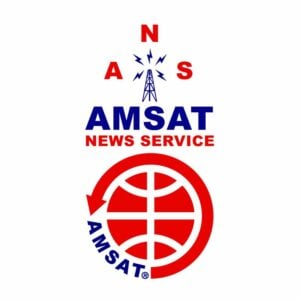

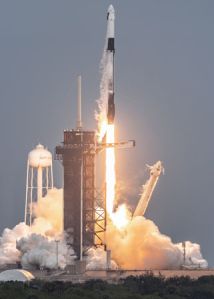
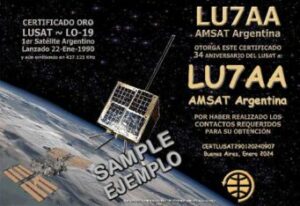
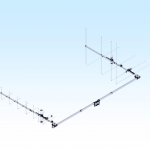

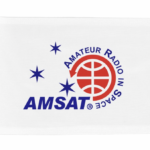
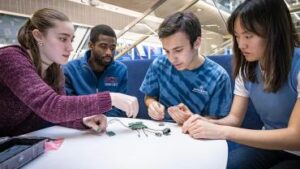
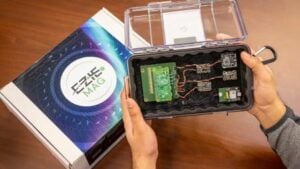

 + Congratulations to Lyle Hood, WB7VUF, for being awarded GridMaster Award #63! This prestigious award, introduced by Star Comm Group in 2014 and sponsored by Damon Runion, WA4HFN, and Rick Tillman, WA4NVM, is now entrusted to AMSAT for the benefit of the entire AMSAT community. The GridMaster Award recognizes amateurs worldwide who establish two-way communication via amateur satellite with operators in all 488 Maidenhead grids in the contiguous United States of America. More information about this award can be found on the AMSAT website at
+ Congratulations to Lyle Hood, WB7VUF, for being awarded GridMaster Award #63! This prestigious award, introduced by Star Comm Group in 2014 and sponsored by Damon Runion, WA4HFN, and Rick Tillman, WA4NVM, is now entrusted to AMSAT for the benefit of the entire AMSAT community. The GridMaster Award recognizes amateurs worldwide who establish two-way communication via amateur satellite with operators in all 488 Maidenhead grids in the contiguous United States of America. More information about this award can be found on the AMSAT website at 
